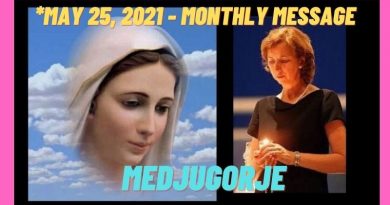Miracles of Our Lady of Lourdes Conquered Scientism
February 11 is the Feast of Our Lady of Lourdes. She conquered Scientism, which is the excessive belief and an exaggerated trust in the power of scientific knowledge and techniques.
Pope Benedict XVI wrote, “Progress and science have given us the power to dominate the forces of nature, to reproduce living things, almost to the point of manufacturing humans themselves. In this situation, praying to God appears pointless, because we can build and create whatever we want. We don’t realize we are reliving the same experience as Babel.” [See Genesis 11:1-9]
By the 1850s, during the Second Empire under Napoleon III (1852–1870), the Secularist fruits of the French revolutions led many French people to believe in Scientism and to disbelieve in miracles, especially miraculous healings.
Scientism is the ideology and belief that only science can explain the truth and reality of creation. This statement is a self-refutation of itself. Science cannot prove the statement. This judgment in no way undermines real science, but helps to keep it within the boundaries of its own field of knowledge.
Science can only explain the “how” of material creation through the scientific method of investigation, observation, experimentation, testing, analysis and conclusions. Science cannot explain anything that transcends the material world such as the supernatural realities of God, angels, saints and miracles nor the natural realities that are not material such as goodness, truth, beauty and love.
The French Secularists believed that only science would be necessary for humanity’s progress. They disbelieved in God, his revelations, the supernatural and especially in his miracles. So, God sent his Mother to disprove their false beliefs.
On February 11, 1858, just outside of the town of Lourdes, France, the Blessed Virgin Mary appeared to 14-year old Bernadette Soubirous. She told her mother that a “lady” holding a Rosary spoke to her in the cave of Massabielle while she was gathering firewood with her sister and a friend. There was a total of 18 apparitions between February and July of 1858.

On March 25, Our Lady told Bernadette, “I am the Immaculate Conception.” This was a confirmation of the ejaculation that Our Lady revealed to St. Catherine Laboure in 1830, “O Mary, conceived without sin, pray for us who have recourse to thee.” It was also a confirmation of the dogma proclaimed just four years before, in 1854, that the Blessed Virgin Mary was immaculately conceived without stain of Original Sin.
On February 25, Bernadette said that Our Lady asked her to dig in the ground and drink from the spring she found there. She did so and the spring water was the agent of many miracles after that. The first miracle occurred on March 1.
In 1859, Professor Vergez of the Faculty of Medicine at Montpellier was appointed to examine the Lourdes cures. Seven cures were recorded before 1862. Since then, almost 7,000 cures have been documented at the waters of Lourdes. The Church has rigorously investigated and validated 67 of them.
God had used his Mother to disprove the prevalence in France of disbelief in God, through the supernatural and especially his miracles. In spite of that, some people will always disbelieve and will never believe in these supernatural realities.
Emile Zola, the late nineteenth-century French novelist, erroneously believed that science had cleared up all of the mysteries of the world. In August 1892, Zola went to Lourdes to gather evidence that no miracles had occurred there. However, by God’s providence he actually witnessed two miracles.
18-year-old Marie Lemarchand was afflicted with three seemingly incurable diseases. She had an advanced stage of lupus, pulmonary tuberculosis, and leg ulcerations the size of an adult’s hand. Zola described the girl’s face as being eaten away by the lupus. He wrote, “The whole was a frightful distorted mass of matter and oozing blood.” Marie entered the baths of water at Lourdes and came out completely cured.
Zola was there when she came out and said, “I only want to see a cut finger dipped in water and come out healed.” The President of the Medical Bureau, Dr. Boissarie, was standing beside him and said, “Ah, Monsieur Zola, behold the case of your dreams!”
“I don’t want to look at her,” replied Zola. “To me she is still ugly.” And he walked away. He denied the very reality of her miraculous cure that appeared before his very eyes. So, God gave him a second chance.
Zola witnessed a second miracle of the healing of a woman in the final stages of tuberculosis. Nevertheless, he told Dr. Boissarie, “Were I to see all the sick at Lourdes cured, I would not believe in a miracle.”
That’s not science, that’s disbelief with a blind faith only in science in spite of the miraculous reality that was shown to him.
The truth is that science is the study of the material natural world. It has nothing to teach us about the supernatural, such as miracles, that are outside of nature, but nevertheless real.
When St. Bernadette’s body was exhumed on September 23, 1909, thirty years after her death, it was found to be incorrupt.
Pope Benedict XVI wrote,
Francis Bacon [a 17th century English philosopher who is credited with developing the scientific method] and those who followed in the intellectual current of modernity that he inspired were wrong to believe that man would be redeemed through science. Such an expectation asks too much of science; this kind of hope is deceptive. Science can contribute greatly to making the world and mankind more human. Yet it can also destroy mankind and the world unless it is steered by forces that lie outside it… It is not science that redeems man: man is redeemed by love. (Saved in Hope 25-26).
However, many people still believe that science redeems man. They believe that “the New Age which is dawning will be peopled by perfect, androgynous beings who are totally in command of the cosmic laws of nature. In this scenario, Christianity has to be eliminated and give way to a global religion and a new world order.” (Jesus Christ, The Bearer of the Water of Life, A Christian reflection on the “New Age” 4, February 2, 2003).
This sounds as proudly arrogant as the boast of the builders of the Tower of Babel, a tower that men tried to build to reach the heavens by a united humanity. God punished them and confused their speech so that they could not understand one another and scattered them around the world. (See Genesis 11:1-9).
Pope Benedict XVI wrote, “Progress and science have given us the power to dominate the forces of nature, to manipulate the elements, to reproduce living things, almost to the point of manufacturing humans themselves. In this situation, praying to God appears outmoded, pointless, because we can build and create whatever we want. We don’t realize we are reliving the same experience as Babel.” (Pope Benedict XVI, Pentecost Homily, May 27th, 2102.)





